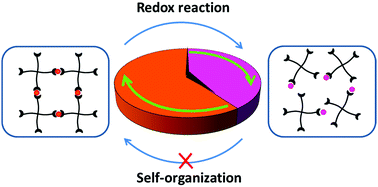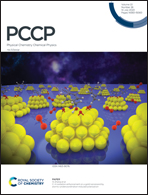Efficiency range of the Belousov–Zhabotinsky reaction to induce the self-organization of transient bonds in metallo-supramolecular polymeric systems†
Abstract
The periodic change of the oxidation state of the metal catalyst in the oscillating Belousov–Zhabotinsky (BZ) reaction has been reported to establish a periodic organization of metallo-supramolecular bonds in polymeric systems, which results in autonomous viscosity oscillations. To appraise the possible extent of quantitative control on the viscosity oscillation features, we assess how the kinetics of the BZ reaction affects the periodic self-organization of the metal–ligand coordination, and vice versa. Our model system includes mono-, bis-, and tetra-functional polyethyleneglycol (PEG) precursors end grafted with terpyridine ligands that are complexed with ruthenium ions, which oscillate between Ru2+ and Ru3+ oxidation states in the BZ reaction medium. The control parameters are divided into microscopic factors, which are responsible for the local reaction rate, and mesoscopic factors, which are responsible for the spatial distribution of the concentration patterns. The reactant concentrations are found to nonlinearly control the amplitude and periods of reduction and oxidation phases, independent of the precursor functionalization degree. An increased medium viscosity, and therewith cease of mixing, accelerates the reaction rate by localization of the reaction phases, even though the diffusion of reaction intermediates causes a periodic chemical wave with distinct harmonics. Time-course viscosity measurements of the tetra-arm precursors in the BZ medium demonstrate an initial overshoot followed by minor oscillations around a plateau that is significantly lower than the viscosity of an equivalent fully associated network. Apparently, the slow association kinetics of Ru2+-bis(terpyridine) limits the frequency and the extent of self-organization, and this way, avoids full establishment of the expected viscosity oscillation.



 Please wait while we load your content...
Please wait while we load your content...